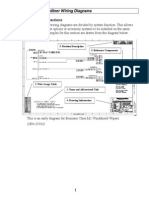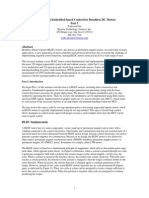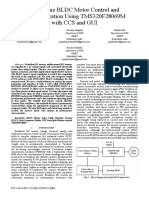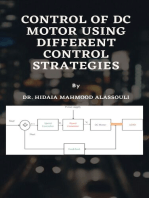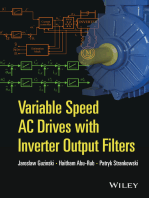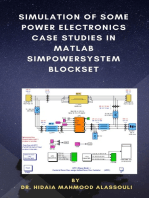Modeling of Sensorized BLDC Motor Speed Control Using
Uploaded by
No OneModeling of Sensorized BLDC Motor Speed Control Using
Uploaded by
No OneIOSR Journal of Electrical and Electronics Engineering (IOSR-JEEE)
e-ISSN: 2278-1676,p-ISSN: 2320-3331, Volume 13, Issue 6 Ver. I (Nov-Dec. 2018), PP 67-76
www.iosrjournals.org
Modeling of sensorized BLDC Motor speed control using
MATLAB/SIMULINK
Binmaya Kumar Dash1, S.Roshni2
1(Department Of Electrical Engineering, Gandhi Engineering College, India)
2(Department Of Electrical Engineering, Gandhi Institute For Technology, India)
Abstract: Recent developments in the field of magnetic materials and power electronics, along with the
availability of cheap powerful processors, have increased the adoption of brushless direct current (BLDC)
motors for various applications, such as in home appliances as well as in automotive, aerospace, and medical
industries. The wide adoption of this motor is due to its many advantages over other types of motors, such as
high efficiency, high dynamic response, long operating life, relatively quiet operation, and higher speed ranges.
This paper presents a simulation of digital sensor control of permanent magnet BLDC motor speed using the
MATLAB/SIMULINK environment. A closed loop speed control was developed, and different tests were
conducted to evaluate the validity of the control algorithms. Results confirm the satisfactory operation of the
proposed control algorithms.
Key Word:BLDC motors Hall sensors Modeling Speed control
I. Introduction
Brushless direct current (BLDC) variable speed drives are increasingly applied in many new industrial
applications. Recent developments in power electronics and semiconductor technology have led to their
widespread use [1]. This type of motor is now more popular in applications, such as for electric vehicles, due to
its energy-efficient consumption [2]. Furthermore, the BLDC motor has many advantages over the induction
motor and brushed DC motor, including better efficiency, power factor, less maintenance, longer life, and less
rotor inertia. BLDC motor is also easier to control with its trapezoidal configuration. This study utilizes a three-
phase BLDC motor with trapezoidal back EMF [3]. The brushes and commutators have been eliminated, and the
windings are connected to the control circuits. Commutation is done electronically instead of using brushes [4].
Because such motors have no brushes, they need a solid state commutation circuit in order to supply the stator
windings according to the rotor position [5]. Rotor position can be obtained by either a shaft encoder or, more
often, by Hall Effect sensors [6].
The dynamic features and digital control of the BLDC motor furthered its wide utilization in different
high and low power applications, compared with other types of motors. Moreover, these motors became one of
the major components used to develop 3D printers due to its compatibility and easy integration with used digital
controllers [7], which are digitally controlled through power electronic converters integrated with high speed
microcontroller. The use of such devices enabled an easy adaption of BLDC motors in 3D printers and Internet
of Things (IoT) devices [8]. Nowadays, real-time connection technologies, either at the residential or industrial
level, is considered as the primary technology that established a wide range of IoT applications, such as smart
homes and automated industrial applications [9].A review of the variety of microcontroller-based applications
shows the rapid developments in science and technology. The advantages in developing embedded
microcontrollers in many industrial applications realized remote monitoring and using wireless/wired techniques
of different systems [10]. A BLDC motor drive can be considered a digitally controlled drive system. Therefore,
sensors are implemented to realize control and drive system [11]. This is mainly required for rotor position. The
commutation process was accomplished using a digitally controlled inverter based on Hall-effect sensors
signals. The BLDC motors are characterized by their rectangular current, which needs six discrete rotor
positions [7].
Permanent magnets create the rotor flux, and the energized stator windings create electromagnet poles.
By using the appropriate sequence to supply the stator phases, a rotating field on the stator is created and
maintained. According to the rotor position, the phase windings are switched in a sequence to obtain the rotation
[4]. The speed of a motor can be controlled using open loop control. However, accurate speed control is
necessary in various applications, which can only be achieved by closed loop speed control [12]. The torque
produced in a BLDC motor with trapezoidal back electromotive force (BEMF) is not constant due to torque
ripples that appear on the delivered output torque. These torque ripples are an issue that could highly affect the
BLDC drive system performance [7, 11]. In this paper, digital closed loop speed control is used by
implementing control algorithms in MATLAB/SIMULINK [13].
DOI: 10.9790/1676- 1306016776 www.iosrjournals.org 67 | Page
Modeling of sensorized BLDC Motor speed control using MATLAB/SIMULINK
The performance of a BLDC motor control based on a single sensor for position detection is presented
[14]. The proposed design, which replaces the three conventional sensors with a single one, reduces cost and
complexity. In addition, the proposed drive system will be powered directly from the PV system, based on the
designed high voltage-gain DC-DC converter. MATLAB/SIMULINK results showed a proper operation of
BLDC motor for variable ramped up and down speeds with fixed torque [14]. Another study presented the speed
control of BLDC motor control using Single Input Fuzzy PI Controller as a replacement for the commonly used
conventional linear controller. The advantages of the proposed system include a single control configuration
which combines the performance of different systems. The performance of the proposed system, compared with
the conventional system, showed a better dynamic response [15].
II. Construction And Operation Principle
Motor construction
The BLDC motor is an AC synchronous motor. It is basically inside-out DC motor as it has the
windings on the stator and the rotor is a permanent magnet, as shown in Figure 1 [16]. The main function of the
brushes in the DC motor is to reverse the polarity of the electric current using the mechanical commutator. This
process results in heating and sparks during the motor operation, in addition to electrical losses, which in return
require periodic maintenance. The issue with current commutation can be overcome using electronic
commutation. The polarity reversal in the brushless DC motor is performed by the semiconductor power
switches. A group of hall-effect sensors is used to synchronize the switching with instantaneous rotor position.
The most commonly used sensor control is the six step control. This control is based on capturing the rotor
position at six angles using the hall sensors. The sensor signal is needed to align the applied voltage with the
motor back-EMF. To validate this type of control, a power converter, with the control based on rotor position
measurement, is required. The extra cost for power converter is compensated by the advantage the BLDC drive
system offers over DC motors, and also by the decreasing prices of power components and control circuits.
Other advantages include excellent performance and higher reliability with low maintenance requirement [17].
Figure 2 shows the motor circuit and its connection to the inverter.
Figure 1. Structure of BLDC motor
Figure 2. Motor connection to the inverter
Excluding the mutual inductance between phase windings, the motor equations can be expressed as:
= + Ld/dt+
= + Ld/dt+
= + Ld/dt+
Te=1/ωm (eaia+ebib+ecic)
DOI: 10.9790/1676- 1306016776 www.iosrjournals.org 68 | Page
Modeling of sensorized BLDC Motor speed control using MATLAB/SIMULINK
Motor operation and control
The BLDC motor detects the position of the rotor using Hall sensors. Three sensors, HA, HB, and HC
are required for position information. With three sensors, six possible valid commutation sequences could be
obtained. Every 60 electrical degrees of rotation, one of the Hall sensors changes state. Therefore, it takes six
steps to complete an electrical cycle [18]. Table 1 shows the switching sequence used to run the motor in the
clockwise direction. Figure 3 shows the Hall sensor signals with respect to back EMF and the phase currents [3,
19, 20].
Table 1. Sequence for rotating the motor in clockwise direction
Hall sensor Hall sensor Hall sensor Active Phase Phase Phase
Sequence
A (HA) B (HB) C (HC) Switches Current A Current B Current C
1 1 1 0 S3,S2 0 +1 -1
2 1 0 0 S1,S2 +1 0 -1
3 1 0 1 S1,S6 +1 -1 0
4 0 0 1 S5,S6 0 -1 +1
5 0 1 1 S5,S4 -1 0 +1
6 0 1 0 S3,S4 -1 +1 0
According to Table 1 and Figure 3, for sequence 1, S3 and S2 are switched on, and accordingly, Phase
B current is positive, Phase C current is negative, and Phase A current is zero. In Figure 4, we can see the
energized windings and the stator electromagnetic field ( ST) resulting from this situation. In the same figure,
we can see the rotor magnetic field ( R) forming 120 electrical degrees with the stator electromagnetic field. For
sequence 2, S1 and S2 are switched on, and accordingly, Phase A current is positive, Phase C current is
negative, and Phase B current is zero. In Figure 5, we can see the energized windings and the stator
electromagnetic field ( ST) resulting from this situation. In the same figure we can see the rotor magnetic field (
R) forming 120 electrical degrees with the stator electromagnetic field. For sequence 3, S1 and S6 are switched
on, and accordingly, Phase A current is positive, Phase B current is negative, and Phase C current is zero.
In Figure 6, we can see the energized windings and the stator electromagnetic field ( ST) resulting from
this situation. In the same figure, we can see the rotor magnetic field ( R) forming 120 electrical degrees with
the stator electromagnetic field. For sequence 4, S5 and S6 are switched on. Accordingly, Phase C current is
positive, Phase B current is negative, and Phase A current is zero. In Figure 7, we can see the energized
windings and the stator electromagnetic field ( ST) resulting from this situation. In the same figure, we can see
the rotor magnetic field ( R) forming 120 electrical degrees with the stator electromagnetic field. For sequence
5, S5 and S4 are switched on. Accordingly, Phase C current is positive, Phase A current is negative, and Phase B
current is zero.
Figure 3. Wave forms of Hall sensors, BEMF, torque and phase currents
DOI: 10.9790/1676- 1306016776 www.iosrjournals.org 69 | Page
Modeling of sensorized BLDC Motor speed control using MATLAB/SIMULINK
Figure 4. Sequence 1 Figure 5. Sequence 2
Figure 6. Sequence 3 Figure 7. Sequence 4
In Figure 8, we can see the energized windings and the stator electromagnetic field ( ST) resulting from
this situation. In the same figure, we can see the rotor magnetic field ( R) forming 120 electrical degrees with
the stator electromagnetic field. For sequence 6, S3 and S4 are switched on, and accordingly, Phase B current is
positive, Phase A current is negative, and Phase C current is zero. In Figure 9, we can see the energized
windings and the stator electromagnetic field ( ST) resulting from this situation. In the same figure, we can see
the rotor magnetic field ( R) forming 120 electrical degrees with the stator electromagnetic field [21]. From the
above considerations, we can see that the relative position between stator and rotor magnetic fields at the
beginning of all the six sequences is 120 electrical degrees.
Figure 8. Sequence 5 Figure 9. Sequenc6
If returned back to sequence 1, at the beginning of the sequence, the relative position between the stator
and rotor fields is 120 electrical degrees, as shown in Figure 10. Assuming that after 30 electrical degrees the
rotor position become as shown in Figure 11, this means that the stator magnetic field and the rotor magnetic
field are now perpendicular. If the same considerations are made at the end of sequence 1 and before the
beginning of sequence 2, then we still have the same stator field, whereas the rotor field has moved by another
30 electrical degrees in clockwise, as shown in Figure 12. The angle between stator and rotor magnetic fields is
60 electrical degrees.
DOI: 10.9790/1676- 1306016776 www.iosrjournals.org 70 | Page
Modeling of sensorized BLDC Motor speed control using MATLAB/SIMULINK
By studying the relative position between stator and rotor magnetic fields during all the 6 sequences, it is found
that it varies between 60 and 120 electrical degrees with an average value of 90 degree. Figure 10 shows the
relative position of stator and rotor magnetic fields at the beginning of sequence 1 (120o). Figure 11 shows the
relative position of the same magnetic fields in the middle of sequence 1 (90 o). Figure 12 shows the relative
position of the same two magnetic fields at the end of sequence 1 (60o).
Figure 10. Relative position of stator and rotor magnetic fields at (120o)
Figure 11. Relative position of stator and rotor Figure 12. Relative position of stator and rotor
magnetic fields at (90o) magnetic fields at (60o)
Closed loop speed control
The closed loop speed control of BLDC is shown in Figure 13. The speed of the motor ωm is compared
with the reference ωm* speed value, and speed error Δωm is processed by a proportional-Integrative PI
controller. The output of this controller is considered as the reference current. A current limiter is put on the
output depending on maximum permissible windings currents [4, 22-24].
Figure 13. The closed loop speed control of BLDC
Depending on the rotor position, the reference current generator block generates three-phase reference
currents, Ia*, Ib*, and Ic*, by taking the value of the PI speed controller and limiter. The reference currents are
fed to the Hysteresis current controller [4]. The hesteresis current controller contributes to the generation of
DOI: 10.9790/1676- 1306016776 www.iosrjournals.org 71 | Page
Modeling of sensorized BLDC Motor speed control using MATLAB/SIMULINK
switching signals for the inverter. Hesteresis-band PWM is basically an instantaneous feedback current control
method of PWM, where the actual current continually tracks the command current within hysteresis-band, as
shown in Figure 14. As current exceeds upper band limit (UBL), the upper switch turns off and the lower switch
turns on. As the current exceeds the lower band limit (LBL), upper switch turns on and lower switch turns off
[4].
Figure 14. Hesteresis controller
The switching pattern for the proposed model is shown in Table 2 [25]. This clarifies the sequence
needed to drive the power switches of the inverter in the appropriate manner. The sequence form the base to
design the suitable algorithm to drive the BLDC motor.
Table 2. Switching pattern
Case Activated switch
IA ˃ UBL S1 is off and S4 is on
IA < LBL S1 is on and S4 is off
IB ˃ UBL S3 is off and S6 is on
IB < LBL S3 is on and S6 is off
IC ˃ UBL S5 is off and S2 is on
IC < LBL S5 is on and S2 is off
The closed loop speed control block, as shown in Figure 13, is implemented in MATLAB/SIMULINK,
shown in Figure 15. The shown figure presents the complete system in the BLDC motor and its connection with
the drive and control side, based on sensored operation.
Figure 15. MATLAB/SIMULINK closed loop speed control block diagram
DOI: 10.9790/1676- 1306016776 www.iosrjournals.org 72 | Page
Modeling of sensorized BLDC Motor speed control using MATLAB/SIMULINK
III. Simulation Results
The BLDC motor drive used for simulation is shown in Figure 15. The specifications of the BLDC
motor are listed in Table 3. Different simulation parameters have been captured. In the following figures, some
of the results, relative to a step speed of 1500 rpm and load torque of 10 Nm, are included.
Table 3. Motor parameters
Parameters
No. of poles 2
No. of phases 3
Type of connection Star
Resistance /Ph 0.2 Ω
Self-inductances 0.0085 H/Ph
Moment of inertia 0.89 Kg/m2
Torque constant 1.4
The speed response and reference speed are shown as in Figure 16. The electromagnetic torque
developed by the motor is shown in Figure 17. The shown results of the proposed design revealed a satisfactory
speed and torque response. In Figure 18, the steady-state reference currents are shown. In addition, in Figure 19,
steady-state reference and real currents are shown.
Figure 16. Speed response for a step of 1500 rpm, load torque 10 Nm
Figure 17. Torque developed for a step speed of 1500 rpm, load torque 10 N
DOI: 10.9790/1676- 1306016776 www.iosrjournals.org 73 | Page
Modeling of sensorized BLDC Motor speed control using MATLAB/SIMULINK
Figure 18. Steady-state reference currents for speed of 1500 rpm and load torque of 10 Nm
Figure 19 Steady-state reference and real currents for speed of 1500 rpm and load torque of 10 Nm
The three-phase trapezoidal back EMF (ea, eb, ec), are shown in Figure 20. Figure 21 shows the Hall
Effect sensor, HA, BEMF ea, and phase A real current and torque. The different speed responses and references
for different speed steps are shown in Figure 22. The presented results show a satisfactory response at various
motor speeds. The output current and EMF generated by BLDC motor are shown in Figure 23. The results of the
developed motor controller show a smooth output EMF and current.
Figure 20. BEMF (ea, eb and ec) for speed of 1500 rpm and load torque of 10 Nm
DOI: 10.9790/1676- 1306016776 www.iosrjournals.org 74 | Page
Modeling of sensorized BLDC Motor speed control using MATLAB/SIMULINK
Figure 21. Hall sensor A, BEMF (ea), phase current A and torque for speed of 1500 rpm and load torque of 10
Nm
Figure 22. Speed responses for different step speeds, load torque 10 Nm
Figure 23. The output current and EMF toruge ripples generated
IV. Conclusion
In this paper, the main features of the BLDC motor were discussed and analyzed. A model of the digital speed
control of BLDC Motor, in clockwise and counterclockwise directions, is presented. The presented model was
successfully developed in Matlab/Simulink environment and tested at different speeds. The simulation results
confirmed the validity of the proposed controller in terms of satisfactory operation. The proposed design
exhibited a good dynamic performance and speed regulation.
References
[1] P. K. Sharma and A. S. Sindekar, “Performance analysis and comparison of BLDC motor drive using PI and FOC,” pp. 485-492,
2017.
[2] W. A. Salah, et al., “Electric vehicle technology impacts on energy,” International Journal of Power Electronicsand Drive Systems,
vol/issue: 10(1), pp. 1-9, 2019.
[3] J. Rizk, et al., “Brushless DC motor control using a digital signal controller,” in Proceedings of the 5th WSEASinternational
conference on Circuits, systems and signals (CSS’11), pp. 23-28, 2011.
DOI: 10.9790/1676- 1306016776 www.iosrjournals.org 75 | Page
Modeling of sensorized BLDC Motor speed control using MATLAB/SIMULINK
[4] C. Sanita and J. Kuncheria, “Modelling and simulation of four quadrant operation of three phase brushless DC motor with hysteresis
current controller,” International Journal of Advanced Research in Electrical, Electronicsand Instrumentation Engineering,
vol/issue: 2(6), 2013.
[5] C. Concari and F. Troni, “Sensorless control of BLDC motors at low speed based on differential BEMF measurement,” in Energy
Conversion Congress and Exposition (ECCE), 2010 IEEE, pp. 1772-1777, 2010.
[6] B. Sensored, “Motor Control Using dsPIC30F2010,” Microctfip Technology Inc, vol/issue: 2(004), 2004.
[7] W. A. Salah, et al., “Implementation of PWM control strategy for torque ripples reduction in brushless DC motors,” Electrical
Engineering, vol/issue: 97(3), pp. 239-250, 2015.
[8] M. A. M. Albreem, et al., “Green internet of things (IoT): An overview,” in 2017 IEEE 4th InternationalConference on Smart
Instrumentation, Measurement and Application (ICSIMA), pp. 1-6, 2017.
[9] S. Stoukatch, et al., “Additive low temperature 3D printed electronic as enabling technology for IoT application,” in 2017 IEEE
19th Electronics Packaging Technology Conference (EPTC), pp. 1-6, 2017.
[10] W. A. Salah and B. A. Zneid, “Evolution of Microcontroller-based Remote Monitoring System Applications,” International Journal
of Electrical and Computer Engineering, vol/issue: 9(4), 2019.
[11] W. A. Salah, et al., “Minimization of torque ripples in BLDC motors due to phase commutation - A review,” Przeglad
Elektrotechniczny (Electrical Review), vol/issue: 87(1), pp. 183-188, 2011.
[12] L. A. Jose and K. Karthikeyan, “A comparative study of sinusoidal PWM and space vector PWM of a vector controlled BLDC
motor,” International Journal of Advanced Research in Electrical, Electronics andInstrumentation Engineering, vol/issue: 2(6), pp.
2662-2668, 2013.
[13] V. G. TK, et al., “DSP based Speed Control of Permanent Magnet Brushless DC Motor.”
[14] G. G. R. Sekhar and B. Banakara, “Performance of brushless DC drive with single current sensor fed from PV with high voltage-
gain DC-DC converter,” International Journal of Power Electronics and Drive Systems, vol/issue: 9(1), pp. 33-45, 2018.
[15] N. N. Baharudin and S. M. Ayob, “Brushless DC motor speed control using single input fuzzy PI controller,” International Journal
of Power Electronics and Drive Systems, vol/issue: 9(4), pp. 1952-1966, 2018.
[16] M. T. Inc, “Sensored BLDC Motor Control using Dspic30F2010,” in AN957, 2004.
[17] G. Prasad, et al., “Speed control of Brushless DC motor with DSP controller using Matlab,” International Journalof Engineering
Research and Applications (IJERA), vol/issue: 2(3), pp. 2120-2125, 2012.
[18] R. Yanamshetti and J. N. Ansari, “Microcontroller Controlled BLDC Drive for Electric Vehicle,” InternationalJournal of
Engineering, vol/issue: 1(10), 2012.
[19] M. F. Tsai, et al., “Model construction and verification of a BLDC motor using MATLAB/SIMULINK and FPGA control,” in
Industrial Electronics and Applications (ICIEA), 2011 6th IEEE Conference on, pp. 1797-1802, 2011.
[20] P. Yedamale, “Brushless DC (BLDC) Motor Fundamentals,” Microchip Technology Inc, Application note, vol. AN885, 2003.
Available: http://ww1.microchip.com/downloads/en/AppNotes/00885a.pdf.
[21] L. Bonometti, “Convertitori di potenza e servomotori brushless,” UTET periodici, 2001.
[22] G. R. P. Lakshmi and S. Paramasivam, “dsPIC based Power Assisted Steering using Brushless Direct Current motor,” American
Journal of Applied Sciences, vol/issue: 10(11), pp. 1419-1426, 2013.
[23] M. Naseeruddin and A. M. Prasad, “Analysis of the speed control of BLDC motor on matlab/simulink,” in NationalConference On
Electrical Sciences-2012 (NCES-12), pp. 978-93, 2012.
[24] W. Brown, “Brushless dc motor control made easy,” Microchip Technology Inc, pp. 1-48, 2002.
[25] U. Vinatha, et al., “Simulation of four quadrant operation & speed control of BLDC MOTOR on MATLAB / SIMULINK,” 2008.
DOI: 10.9790/1676- 1306016776 www.iosrjournals.org 76 | Page
You might also like
- Body Controller Diagnostic Trouble Codes International 3200, 4100, 4300, 4400, 7300, 7400, 7500, 7600, 7700, 8500, 8600 Fault Code List PDF100% (7)Body Controller Diagnostic Trouble Codes International 3200, 4100, 4300, 4400, 7300, 7400, 7500, 7600, 7700, 8500, 8600 Fault Code List PDF30 pages
- 1984 GMC Light Duty Trucks Service Manual95% (19)1984 GMC Light Duty Trucks Service Manual1,746 pages
- Detroit GHG17 Heavy Duty Troubleshooting Manual PDF100% (22)Detroit GHG17 Heavy Duty Troubleshooting Manual PDF3,104 pages
- Trailer Life RV Repair and Maintenance Manual (PDFDrive)100% (3)Trailer Life RV Repair and Maintenance Manual (PDFDrive)496 pages
- Wiring Diagrams+Service Manuals+EWD+E-books+Software10% (21)Wiring Diagrams+Service Manuals+EWD+E-books+Software91 pages
- Bendix EC-80 ABS / ATC Controllers: (ABS) Devices Designed To Help Improve The Braking100% (3)Bendix EC-80 ABS / ATC Controllers: (ABS) Devices Designed To Help Improve The Braking44 pages
- Kitchen Aid k45 Service Manual For Hobart Made Vintage Mixers Compress100% (1)Kitchen Aid k45 Service Manual For Hobart Made Vintage Mixers Compress30 pages
- (Hack) Cellular-Manual - Cell Phone Phreaking83% (18)(Hack) Cellular-Manual - Cell Phone Phreaking24 pages
- Sliding Mode Observer For Torque Control in Sensorless BLDC MotorNo ratings yetSliding Mode Observer For Torque Control in Sensorless BLDC Motor5 pages
- Ijert Ijert: Microcontroller Controlled BLDC Drive For Electric Vehicle Raju Yanamshetti, Juhi Nishat AnsariNo ratings yetIjert Ijert: Microcontroller Controlled BLDC Drive For Electric Vehicle Raju Yanamshetti, Juhi Nishat Ansari4 pages
- Position Compensation Method of BLDC Motor For Automotive ApplicationsNo ratings yetPosition Compensation Method of BLDC Motor For Automotive Applications7 pages
- Modelling of Sensored Speed Control of BNo ratings yetModelling of Sensored Speed Control of B11 pages
- Simulation of Brushless DC Motor Speed Control in Matlab-Ijaerdv04i12901510% (1)Simulation of Brushless DC Motor Speed Control in Matlab-Ijaerdv04i12901517 pages
- Four Switch Three Phase Inverter Control of BLDC MotorNo ratings yetFour Switch Three Phase Inverter Control of BLDC Motor6 pages
- DC Link Approach To Variable-Speed, Sensorless,: Induction Motor DriveNo ratings yetDC Link Approach To Variable-Speed, Sensorless,: Induction Motor Drive5 pages
- Field Oriented Control For Space Vector Modulation Based Brushless DC Motor DriveNo ratings yetField Oriented Control For Space Vector Modulation Based Brushless DC Motor Drive8 pages
- Sensorless Speed Control of Brushless DC Motor With Fuzzy Based EstimationNo ratings yetSensorless Speed Control of Brushless DC Motor With Fuzzy Based Estimation7 pages
- Different Types of Speed Controllers For Brushless DC Motor - A ReviewNo ratings yetDifferent Types of Speed Controllers For Brushless DC Motor - A Review10 pages
- A Variable-Speed, Sensorless, Induction Motor Drive Using DC Link MeasurementsNo ratings yetA Variable-Speed, Sensorless, Induction Motor Drive Using DC Link Measurements6 pages
- Simulation of Speed Control of Brushless DC Motor, With Fuzzy Logic ControllerNo ratings yetSimulation of Speed Control of Brushless DC Motor, With Fuzzy Logic Controller6 pages
- Speed Control of Brushless DC Motor Using Fuzzy Logic ControllerNo ratings yetSpeed Control of Brushless DC Motor Using Fuzzy Logic Controller9 pages
- Speed Control of BLDC Motor Using DSP: 1 4 1 JNTUH Hyderabad, India 2 JNTUH Hyderabad, IndiaNo ratings yetSpeed Control of BLDC Motor Using DSP: 1 4 1 JNTUH Hyderabad, India 2 JNTUH Hyderabad, India5 pages
- Identification and Optimization Speed Control of BLDC Motor Using Fuzzy Logic ControllerNo ratings yetIdentification and Optimization Speed Control of BLDC Motor Using Fuzzy Logic Controller5 pages
- Control BLDC Motor Speed Using PID ControllerNo ratings yetControl BLDC Motor Speed Using PID Controller5 pages
- Torque Control of CSI Fed Induction Motor Drives: Electrical Engineering Institute "Nikola Tesla", Belgrade SerbiaNo ratings yetTorque Control of CSI Fed Induction Motor Drives: Electrical Engineering Institute "Nikola Tesla", Belgrade Serbia27 pages
- e3sconf_icseret2023_01001_Performance_Analysis_of_Controllers_In_BLDC_MotorNo ratings yete3sconf_icseret2023_01001_Performance_Analysis_of_Controllers_In_BLDC_Motor11 pages
- Performance Enhancement of BLDC Motor Using PID ControllerNo ratings yetPerformance Enhancement of BLDC Motor Using PID Controller10 pages
- (2024+issue) +ICASETM 2023 - BAL - 0328+ +full+paper AL 1No ratings yet(2024+issue) +ICASETM 2023 - BAL - 0328+ +full+paper AL 17 pages
- An Introduction To Brushless DC Motor ControlNo ratings yetAn Introduction To Brushless DC Motor Control33 pages
- Comparative Study Between Pid and Fuzzy Pid Controller For Speed Control of BLDC Motor IJERTV7IS050098No ratings yetComparative Study Between Pid and Fuzzy Pid Controller For Speed Control of BLDC Motor IJERTV7IS0500986 pages
- A Field-Oriented Control Method Using The Virtual Currents For The Induction Motor DriveNo ratings yetA Field-Oriented Control Method Using The Virtual Currents For The Induction Motor Drive8 pages
- Ee3009-Special Electrical Machines-288337885-Ee 3009 Sem Lab ManualNo ratings yetEe3009-Special Electrical Machines-288337885-Ee 3009 Sem Lab Manual23 pages
- Investigation of Mathematical Modelling of Brushless DC motorBLDC Drives by Using MATLAB-SIMULINKNo ratings yetInvestigation of Mathematical Modelling of Brushless DC motorBLDC Drives by Using MATLAB-SIMULINK6 pages
- Mobile Robot Chapter 7: The Motors of The Robot (V.4a)No ratings yetMobile Robot Chapter 7: The Motors of The Robot (V.4a)18 pages
- Handbook and Application Guide For High-Performance Brushless Servo SystemsNo ratings yetHandbook and Application Guide For High-Performance Brushless Servo Systems26 pages
- Speed Control of Permanent Magnet Brushless DC Motor Using Fuzzy Logic Controller-Hardware ImplementationNo ratings yetSpeed Control of Permanent Magnet Brushless DC Motor Using Fuzzy Logic Controller-Hardware Implementation5 pages
- 2024.01.T. Torque_Ripple_Reduction_of_BLDC_Motor_with_a_Low-Cost_Fast-Response_Direct_DC-Link_Current_ControlNo ratings yet2024.01.T. Torque_Ripple_Reduction_of_BLDC_Motor_with_a_Low-Cost_Fast-Response_Direct_DC-Link_Current_Control10 pages
- Real-Time BLDC Motor Control and Characterization Using TMS320F28069M With CCS and GUINo ratings yetReal-Time BLDC Motor Control and Characterization Using TMS320F28069M With CCS and GUI6 pages
- PID Controller For A Two Quadrant Chopper Fed DC Motor DriveNo ratings yetPID Controller For A Two Quadrant Chopper Fed DC Motor Drive5 pages
- Simplified Sensorless Control For BLDC Motor, Using DSP TechnologyNo ratings yetSimplified Sensorless Control For BLDC Motor, Using DSP Technology12 pages
- Implementation of Brushless DC Motor Speed Control PDFNo ratings yetImplementation of Brushless DC Motor Speed Control PDF7 pages
- Welcome To International Journal of Engineering Research and Development (IJERD)No ratings yetWelcome To International Journal of Engineering Research and Development (IJERD)8 pages
- Position Tracking System With Brushless DC Motor: Keywords: BLDC Motor Hall Sensors PID ControllerNo ratings yetPosition Tracking System With Brushless DC Motor: Keywords: BLDC Motor Hall Sensors PID Controller5 pages
- Fuzzy Based Reconfigurable Controller For BLDC MotorNo ratings yetFuzzy Based Reconfigurable Controller For BLDC Motor7 pages
- Control of DC Motor Using Different Control StrategiesFrom EverandControl of DC Motor Using Different Control StrategiesNo ratings yet
- Advanced Electric Drives: Analysis, Control, and Modeling Using MATLAB / SimulinkFrom EverandAdvanced Electric Drives: Analysis, Control, and Modeling Using MATLAB / SimulinkNo ratings yet
- Simulation of Some Power Electronics Case Studies in Matlab Simpowersystem BlocksetFrom EverandSimulation of Some Power Electronics Case Studies in Matlab Simpowersystem Blockset2/5 (1)
- Simulation of Some Power Electronics Case Studies in Matlab Simpowersystem BlocksetFrom EverandSimulation of Some Power Electronics Case Studies in Matlab Simpowersystem BlocksetNo ratings yet
- TDBE4-U200/300: Plug-In Railway Relay With 4 C/O ContactsNo ratings yetTDBE4-U200/300: Plug-In Railway Relay With 4 C/O Contacts13 pages
- Electro 1 E3 Drawing and Construction of Electrical Circuit in ParallelNo ratings yetElectro 1 E3 Drawing and Construction of Electrical Circuit in Parallel6 pages
- Rear - Panel Spark-Concepts - xPro-V5 Wiki GitHubNo ratings yetRear - Panel Spark-Concepts - xPro-V5 Wiki GitHub9 pages
- Integra Padgett: Electric Dermatome Model BNo ratings yetIntegra Padgett: Electric Dermatome Model B2 pages
- Altium Designer PCB Design Tutorial - PCBCartNo ratings yetAltium Designer PCB Design Tutorial - PCBCart11 pages
- Sycom Sycom Power Power Protecti Protecti NN PVT - Ltd. PVT - LTDNo ratings yetSycom Sycom Power Power Protecti Protecti NN PVT - Ltd. PVT - LTD5 pages
- FALLSEM2018-19 EEE1001 ETH TT305 VL2018191000890 Reference Material I Unit 2 ProblemsNo ratings yetFALLSEM2018-19 EEE1001 ETH TT305 VL2018191000890 Reference Material I Unit 2 Problems45 pages
- Body Controller Diagnostic Trouble Codes International 3200, 4100, 4300, 4400, 7300, 7400, 7500, 7600, 7700, 8500, 8600 Fault Code List PDFBody Controller Diagnostic Trouble Codes International 3200, 4100, 4300, 4400, 7300, 7400, 7500, 7600, 7700, 8500, 8600 Fault Code List PDF
- Detroit GHG17 Heavy Duty Troubleshooting Manual PDFDetroit GHG17 Heavy Duty Troubleshooting Manual PDF
- Trailer Life RV Repair and Maintenance Manual (PDFDrive)Trailer Life RV Repair and Maintenance Manual (PDFDrive)
- Wiring Diagrams+Service Manuals+EWD+E-books+SoftwareWiring Diagrams+Service Manuals+EWD+E-books+Software
- Bendix EC-80 ABS / ATC Controllers: (ABS) Devices Designed To Help Improve The BrakingBendix EC-80 ABS / ATC Controllers: (ABS) Devices Designed To Help Improve The Braking
- Kitchen Aid k45 Service Manual For Hobart Made Vintage Mixers CompressKitchen Aid k45 Service Manual For Hobart Made Vintage Mixers Compress
- Sliding Mode Observer For Torque Control in Sensorless BLDC MotorSliding Mode Observer For Torque Control in Sensorless BLDC Motor
- Ijert Ijert: Microcontroller Controlled BLDC Drive For Electric Vehicle Raju Yanamshetti, Juhi Nishat AnsariIjert Ijert: Microcontroller Controlled BLDC Drive For Electric Vehicle Raju Yanamshetti, Juhi Nishat Ansari
- Position Compensation Method of BLDC Motor For Automotive ApplicationsPosition Compensation Method of BLDC Motor For Automotive Applications
- Simulation of Brushless DC Motor Speed Control in Matlab-Ijaerdv04i1290151Simulation of Brushless DC Motor Speed Control in Matlab-Ijaerdv04i1290151
- Four Switch Three Phase Inverter Control of BLDC MotorFour Switch Three Phase Inverter Control of BLDC Motor
- DC Link Approach To Variable-Speed, Sensorless,: Induction Motor DriveDC Link Approach To Variable-Speed, Sensorless,: Induction Motor Drive
- Field Oriented Control For Space Vector Modulation Based Brushless DC Motor DriveField Oriented Control For Space Vector Modulation Based Brushless DC Motor Drive
- Sensorless Speed Control of Brushless DC Motor With Fuzzy Based EstimationSensorless Speed Control of Brushless DC Motor With Fuzzy Based Estimation
- Different Types of Speed Controllers For Brushless DC Motor - A ReviewDifferent Types of Speed Controllers For Brushless DC Motor - A Review
- A Variable-Speed, Sensorless, Induction Motor Drive Using DC Link MeasurementsA Variable-Speed, Sensorless, Induction Motor Drive Using DC Link Measurements
- Simulation of Speed Control of Brushless DC Motor, With Fuzzy Logic ControllerSimulation of Speed Control of Brushless DC Motor, With Fuzzy Logic Controller
- Speed Control of Brushless DC Motor Using Fuzzy Logic ControllerSpeed Control of Brushless DC Motor Using Fuzzy Logic Controller
- Speed Control of BLDC Motor Using DSP: 1 4 1 JNTUH Hyderabad, India 2 JNTUH Hyderabad, IndiaSpeed Control of BLDC Motor Using DSP: 1 4 1 JNTUH Hyderabad, India 2 JNTUH Hyderabad, India
- Identification and Optimization Speed Control of BLDC Motor Using Fuzzy Logic ControllerIdentification and Optimization Speed Control of BLDC Motor Using Fuzzy Logic Controller
- Torque Control of CSI Fed Induction Motor Drives: Electrical Engineering Institute "Nikola Tesla", Belgrade SerbiaTorque Control of CSI Fed Induction Motor Drives: Electrical Engineering Institute "Nikola Tesla", Belgrade Serbia
- e3sconf_icseret2023_01001_Performance_Analysis_of_Controllers_In_BLDC_Motore3sconf_icseret2023_01001_Performance_Analysis_of_Controllers_In_BLDC_Motor
- Performance Enhancement of BLDC Motor Using PID ControllerPerformance Enhancement of BLDC Motor Using PID Controller
- (2024+issue) +ICASETM 2023 - BAL - 0328+ +full+paper AL 1(2024+issue) +ICASETM 2023 - BAL - 0328+ +full+paper AL 1
- Comparative Study Between Pid and Fuzzy Pid Controller For Speed Control of BLDC Motor IJERTV7IS050098Comparative Study Between Pid and Fuzzy Pid Controller For Speed Control of BLDC Motor IJERTV7IS050098
- A Field-Oriented Control Method Using The Virtual Currents For The Induction Motor DriveA Field-Oriented Control Method Using The Virtual Currents For The Induction Motor Drive
- Ee3009-Special Electrical Machines-288337885-Ee 3009 Sem Lab ManualEe3009-Special Electrical Machines-288337885-Ee 3009 Sem Lab Manual
- Investigation of Mathematical Modelling of Brushless DC motorBLDC Drives by Using MATLAB-SIMULINKInvestigation of Mathematical Modelling of Brushless DC motorBLDC Drives by Using MATLAB-SIMULINK
- Mobile Robot Chapter 7: The Motors of The Robot (V.4a)Mobile Robot Chapter 7: The Motors of The Robot (V.4a)
- Handbook and Application Guide For High-Performance Brushless Servo SystemsHandbook and Application Guide For High-Performance Brushless Servo Systems
- Speed Control of Permanent Magnet Brushless DC Motor Using Fuzzy Logic Controller-Hardware ImplementationSpeed Control of Permanent Magnet Brushless DC Motor Using Fuzzy Logic Controller-Hardware Implementation
- 2024.01.T. Torque_Ripple_Reduction_of_BLDC_Motor_with_a_Low-Cost_Fast-Response_Direct_DC-Link_Current_Control2024.01.T. Torque_Ripple_Reduction_of_BLDC_Motor_with_a_Low-Cost_Fast-Response_Direct_DC-Link_Current_Control
- Real-Time BLDC Motor Control and Characterization Using TMS320F28069M With CCS and GUIReal-Time BLDC Motor Control and Characterization Using TMS320F28069M With CCS and GUI
- PID Controller For A Two Quadrant Chopper Fed DC Motor DrivePID Controller For A Two Quadrant Chopper Fed DC Motor Drive
- Simplified Sensorless Control For BLDC Motor, Using DSP TechnologySimplified Sensorless Control For BLDC Motor, Using DSP Technology
- Implementation of Brushless DC Motor Speed Control PDFImplementation of Brushless DC Motor Speed Control PDF
- Welcome To International Journal of Engineering Research and Development (IJERD)Welcome To International Journal of Engineering Research and Development (IJERD)
- Position Tracking System With Brushless DC Motor: Keywords: BLDC Motor Hall Sensors PID ControllerPosition Tracking System With Brushless DC Motor: Keywords: BLDC Motor Hall Sensors PID Controller
- Fuzzy Based Reconfigurable Controller For BLDC MotorFuzzy Based Reconfigurable Controller For BLDC Motor
- Control of DC Motor Using Different Control StrategiesFrom EverandControl of DC Motor Using Different Control Strategies
- Variable Speed AC Drives with Inverter Output FiltersFrom EverandVariable Speed AC Drives with Inverter Output Filters
- Advanced Electric Drives: Analysis, Control, and Modeling Using MATLAB / SimulinkFrom EverandAdvanced Electric Drives: Analysis, Control, and Modeling Using MATLAB / Simulink
- Simulation of Some Power Electronics Case Studies in Matlab Simpowersystem BlocksetFrom EverandSimulation of Some Power Electronics Case Studies in Matlab Simpowersystem Blockset
- Simulation of Some Power Electronics Case Studies in Matlab Simpowersystem BlocksetFrom EverandSimulation of Some Power Electronics Case Studies in Matlab Simpowersystem Blockset
- TDBE4-U200/300: Plug-In Railway Relay With 4 C/O ContactsTDBE4-U200/300: Plug-In Railway Relay With 4 C/O Contacts
- Electro 1 E3 Drawing and Construction of Electrical Circuit in ParallelElectro 1 E3 Drawing and Construction of Electrical Circuit in Parallel
- Sycom Sycom Power Power Protecti Protecti NN PVT - Ltd. PVT - LTDSycom Sycom Power Power Protecti Protecti NN PVT - Ltd. PVT - LTD
- FALLSEM2018-19 EEE1001 ETH TT305 VL2018191000890 Reference Material I Unit 2 ProblemsFALLSEM2018-19 EEE1001 ETH TT305 VL2018191000890 Reference Material I Unit 2 Problems


